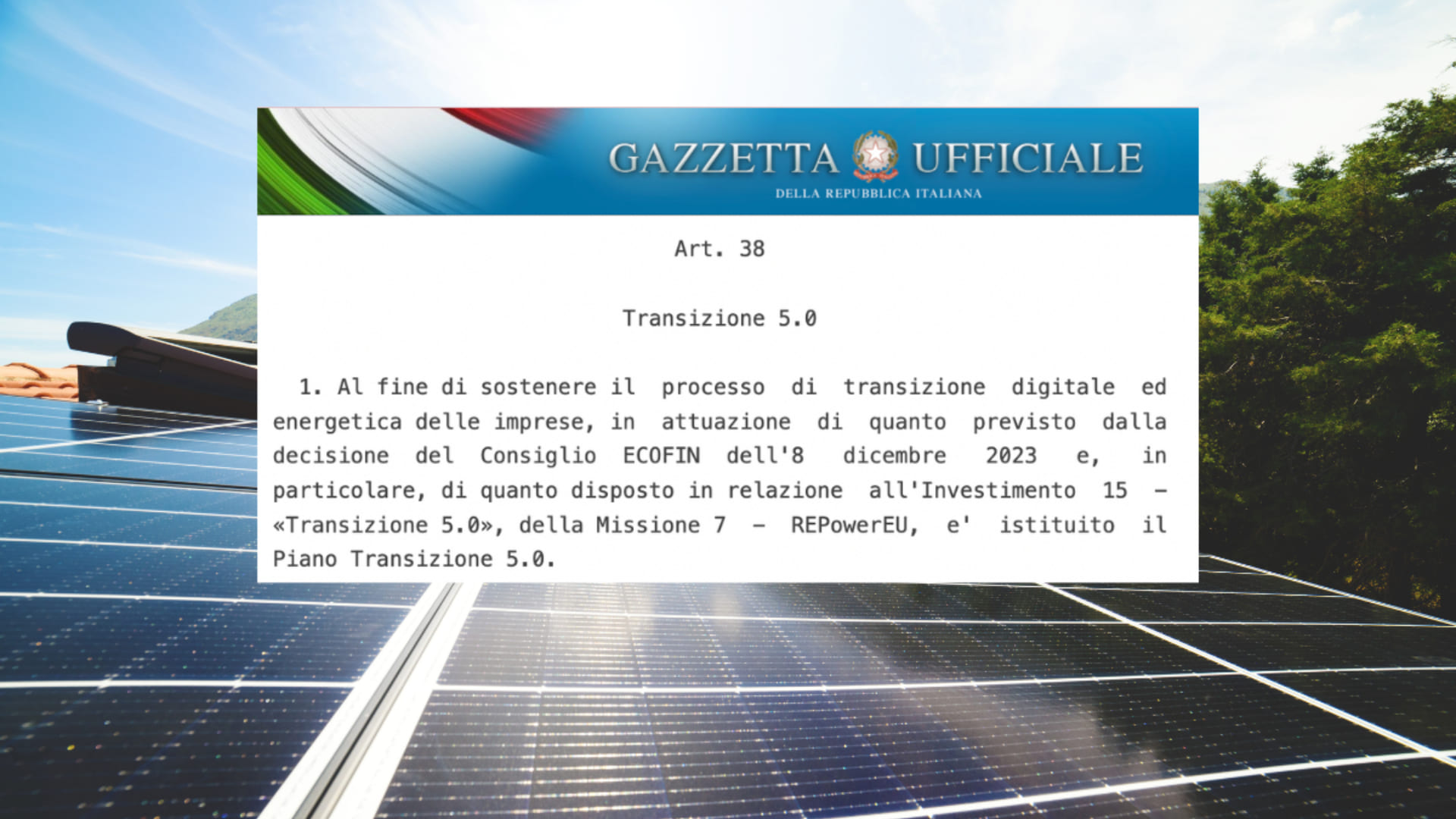
The highly anticipated Transizione 5.0 Plan was published in the Official Gazette under Article 38, after months of waiting by businesses. Although we still need to wait for the implementation guidelines, which will be published within 30 days, let’s analyze in detail the Decree Law to understand how the tax credit for companies works.
The Transizione 5.0 Plan aims to stimulate companies to invest in digitization projects and energy savings. The initiative, valid for the biennium 2024-2025, aims to incentivize companies to make targeted investments in digitization and energy savings. The association of the tax credit with the reduction of energy consumption implies that the tax benefit is exclusively intended for investments aimed at reducing the company’s internal energy consumption. Naturally, speculative investments intended for energy production for sale are excluded.
Eligible Investments
The eligible investments cover the purchase of tangible and intangible goods already specified in the previous Industria 4.0 Plan. The assets included in the Transizione 5.0 tax credit must be specified in Annexes A and B of Law 232/2016 (Industria 4.0). It is important to highlight that the tax credits of Industria 4.0 and Transizione 5.0 are not cumulative.
Transizione 5.0 Tax Credit
The Transizione 5.0 Tax Credit offers three main options:
- Improvement of Energy Efficiency: This encourages the purchase of instrumental goods to enhance production processes while reducing energy consumption. Incentives are also available for investments in self-production renewable energy systems for self-consumption, excluding biomass. For photovoltaic panels, only those registered with ENEA (National Energy Efficiency Agency) are eligible. These panels must be produced within the European Union and classified according to three high-efficiency levels, with a minimum cell efficiency of 21.5%. Further incentives are available for panels with greater efficiency.
- Purchase of Goods for Self-Production from Renewable Sources: Excludes biomass and supports investments in systems for self-production and self-consumption of renewable energy. The eligible investments include the purchase or leasing of instrumental goods, such as machine tools, robots, automated warehouses, and advanced software. These must be interconnected with the factory systems defined by the 2017 Budget Law, which established the Industria 4.0 Plan. However, to benefit from these incentives, the goods must be used in innovative projects that result in a reduction of the energy consumption of the production facility by at least 3%, or at least 5% for processes directly affected by the investment. Additionally, there is an expansion of eligible goods to include software or applications for monitoring consumption and self-produced energy, as well as business management software, if purchased together with these goods.
- Training Expenses: This incentivizes training costs for personnel in topics related to the green transition. Expenses for training on technologies for digital and energy transition can benefit from incentives, but their limit is set at 10% of total investments, which includes both digital instrumental goods and those for self-consumption of renewable energy. However, the maximum limit for training expenses is €300,000. It’s important to note that companies must turn to external trainers to take advantage of this benefit.
The percentages for the tax credit are based on the reduction of energy consumption recorded, detailed as follows:
- Reduction between 3% and 6%, or between 5% and 10% at the individual plant:
– 35% for investments up to €2.5 million;
– 15% for investments between €2.5 million and €10 million;
– 5% for investments over €10 million, with a maximum annual limit of €50 million per company. - Reduction between 6% and 10%, or between 10% and 15% at the individual plant:
– 40% for investments up to €2.5 million;
– 20% for investments between €2.5 million and €10 million;
– 10% for investments over €10 million, with a maximum annual cost of €50 million per company. - Reduction of at least 10%, or at least 15% at the individual plant:
– 45% for investments up to €2.5 million;
– 25% for investments between €2.5 million and €10 million;
– 15% for investments over €10 million, with a maximum annual cost of €50 million per company.
These percentages represent graduated incentives based on the size of investments and the energy efficiency achieved, providing a detailed overview of the available benefits.
Deadlines and Benefits of the Transizione 5.0 Tax Credit
The tax credit can be used in a single solution until December 31, 2025. Any excess can be offset in the following years through 5 annual installments. To certify the achievement of energy efficiency, approval must be obtained from one of the following accredited entities:
- Energy Management Experts (Ege) accredited to Uni Cei 11339;
- Energy Service Companies (Esco) accredited to Uni Cei 11352;
- Organizations accredited under ISO50001 standards;
- Geologists, engineers, and industrial experts registered in the relevant professional orders, as part of the company’s staff conducting the energy audit.
The Transizione 5.0 Plan offers a detailed and structured framework to encourage innovation and energy sustainability within Italian businesses.
Download the Decree of March 2 published in the Official Gazette.